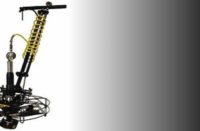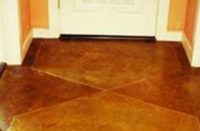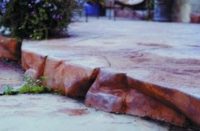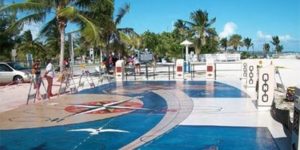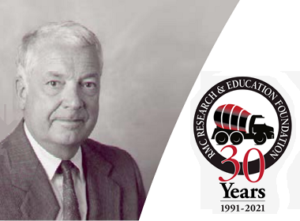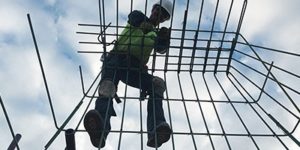 September 11 changed the way we perceive ourselves as a nation. En masse, we watched, horrified, as the very structures of our freedom were shaken to the ground leaving fear and insecurity hanging in the air like dust motes. Even when the dust began to settle, the sense of horror was replaced by something equal as disturbing but more intangible — the feeling of helplessness.
September 11 changed the way we perceive ourselves as a nation. En masse, we watched, horrified, as the very structures of our freedom were shaken to the ground leaving fear and insecurity hanging in the air like dust motes. Even when the dust began to settle, the sense of horror was replaced by something equal as disturbing but more intangible — the feeling of helplessness.
As the nation came to terms with their grief and outrage, others stepped into the debris and began to clear a path for rebirth in hopes that by rebuilding the physical structures that had been destroyed, some part of the American psyche may be patched as well. For those who contributed to this labor, and continue to do so, the work was a way to stymie the tide of helplessness with a wealth of unprecedented effort.
If putting the country back together after September 11 is a jigsaw puzzle, members of the decorative concrete business are a small but integral piece. Without their efficient efforts, the larger-scale effort would not be same. When Isaac Sparks of Hunt Valley Contractors (HVC) in Owings Mills, Maryland received a phone call on October 2 from Nick MacIntosh, assistant project manager for the sub-contractor working on the rebuilding of the Pentagon, he leapt at the opportunity to help with the project. HVC is a specialty concrete subcontractor and a distributor of form liners. The company provides services for colored, imprinted and textured concrete finishes. It is also the exclusive mid-Atlantic distributor for Custom Rock International form liners.
At just 26-years old, Sparks, an estimator, artisan and part owner of HVC, had wrestled with his own sense of helplessness after 9/11. He even considered military service. To work on the Pentagon would give him and his company a chance to put their hardworking hands into action.
MacIntosh’s company, Facchina Construction Co., Inc. had worked with Hunt Valley Contractors on a recent road project. After evaluating the needs of the Pentagon site, he knew to call Hunt Valley Contractors to do the job. The government wanted to recreate the wood textured walls on the interior courtyard walls of rings C, D, and E of the Pentagon and also needed a brick finish that would reach from the foundation to the first floor in the courtyard of ring C.
The government wanted the repair work to exactly match the appearance of the original building. When the Pentagon was built 60 years ago, the walls were formed with 2×4’s that left a wood grain on the walls. HVC needed to obtain a form liner that perfectly matched the 7′ wood plank pattern and another to replicate the weathered brick. There was of course, a catch. Because the government intends to have the Pentagon reopened by September 11 of this year, the deadline for the project was tight and non-negotiable. The construction at the Pentagon was assigned the second highest priority rating available in government, the highest being a direct edict from the president. HVC was ordered, in writing, by the Department of Defense to make the project a priority.
Normally, the turnaround time on a form liner is 3-6 weeks; HVC was turning around product in as little as one week. “We were ordered by the government to do this in a timely fashion,” says Sparks. “Everything else we were working on was to be put on hold until we completed what we needed to for the Pentagon. They needed everything two days ago.” According to Sparks, it was not a difficult sacrifice to make: “My pride as an American wouldn’t have pulled me away. You get to a point where you want to do something to help your country and then this job rolled around and this was my way to do something to help.”
Difficult deadlines were the most challenging aspect of the project, but there were other unusual circumstances to overcome. “We were starting from scratch, with nothing,” says Sparks. “In order to produce anything, I needed time and I wasn’t given time.” That pressure was passed on to Custom Rock International in St. Paul, Minnesota and Scott System of Denver, Colorado, the two form liner manufacturers that HVC contacted to produce the form liners. Custom Rock was responsible for the wood grain and Scott System handled the brick.
 Custom Rock maintains many standard pattern form liners, but the company takes pride in the quality and volume of custom concrete it creates. “One thing we pride ourselves on is being craftsmen,” says Scott Lombard, business manager at Custom Rock. “It’s almost an artistic talent. They really needed to put the details into it to get this exactly how they [the government] wanted it.”
Custom Rock maintains many standard pattern form liners, but the company takes pride in the quality and volume of custom concrete it creates. “One thing we pride ourselves on is being craftsmen,” says Scott Lombard, business manager at Custom Rock. “It’s almost an artistic talent. They really needed to put the details into it to get this exactly how they [the government] wanted it.”
Normally, Custom Rock allows 6-8 weeks to create a custom form liner. They would receive a sample of a finish, recreate it and send the sample to the client for review. With the Pentagon project, they had to work only from photographs. Using the pictures, the manufacturer was able to create samples, send them to Sparks whom, in turn, showed them to the contractor. Through the contractor, the samples were shown to the Department of Defense and the Historical Society before being approved for production. The approved sample was manufactured into 6,000 square-feet of form liner. The entire process was completed in 16 days.
“In this particular situation, the government wanted it done right away,” recalls Lombard. “We were working long hours each day here, literally working Saturdays, Sundays and as many hours in the day we could. When the Department of Defense says ‘jump’ you kind of go ‘okay!’” The project’s efficiency is credited to Jim Bohrer, Sales Director for Form liner, and Jim Kluck, Director of Manufacturing. Jim Kluck took responsibility for meeting the project’s tough deadline.
Custom Rock has received some local press for its efforts on the Pentagon project and Lombard says it has been a real boost to members of its manufacturing team. “That makes everyone feel really good, to know that they are a part of this. It gives everyone a sense of patriotism that the company you work for helped with the reconstruction after something so tragic. We’re very proud of the fact that we were able to participate in this.”
Buck Scott, owner of Scott System, has been in the custom liner business for 35 years. But he never thought he would see the day that Isaac Sparks would fax him a letter from the Department of Defense ordering him to assist in the rebuilding of the Pentagon. Scott still has the letter; he keeps it framed on his office wall as a reminder of his team’s all-out effort. “I was really proud that we flat-out got it done,” he says now. “Guys volunteered to stay late, the truckers all said they were ready to take the load anytime. Everyone just got patriotic and it was fun to do and fun to think that even without that order, we would have thrown our two bits in.”
Sparks went to Scott System for a form liner that would replicate, in concrete, a sixty year-old brick wall. Using email to transmit examples of Scott System’s standard patterns, HVC selected a rough brick (number #176) standard pattern form liner. Scott System produced approximately 1,600 square-feet. Their normal production time is 6-8 weeks. This form liner was ready in three full days.
 “We have really good people, guys who have been with me for years and I trust them,” says Scott. “I just say ‘hey men, we have this to do.’” Everyone pitched in with ideas and offered to come in at night. It was a team effort by my company. They were marvelous.” Scott also points out that the situation was unusual in that he was working side-by-side with a competitor: Custom Rock International. “When Isaac called and said he needed help and it was on the Pentagon, we put that competitiveness aside,” says Scott.
“We have really good people, guys who have been with me for years and I trust them,” says Scott. “I just say ‘hey men, we have this to do.’” Everyone pitched in with ideas and offered to come in at night. It was a team effort by my company. They were marvelous.” Scott also points out that the situation was unusual in that he was working side-by-side with a competitor: Custom Rock International. “When Isaac called and said he needed help and it was on the Pentagon, we put that competitiveness aside,” says Scott.
There aren’t many photographs of the concrete work this team created — security at the Pentagon does not look kindly on too much photography. The representatives of these companies may never set foot into the courtyard of the Pentagon to see the results of their labors. And when the pentagon reopens for business, it is unlikely that anyone will stop and admire the well-apportioned concrete work. But just knowing they could be a small part of this project is a reward in itself.
“I don’t think I’ll ever be able to think about this project without thinking about September 11th. None of us here ever want to get a job like this again,” says Sparks. “It’s great to be part of it, it makes me proud to be a part of it, but when you realize the way the job came about — I hope it never happens again.”
